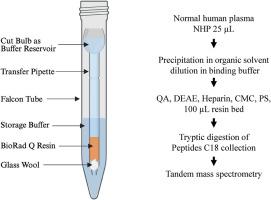用于纳米 LC-ESI-MS/MS 的人体血浆蛋白质微尺度色谱法。
IF 2.6
4区 生物学
Q2 BIOCHEMICAL RESEARCH METHODS
引用次数: 0
摘要
用乙腈对蛋白质进行有机沉淀,可完全回收蛋白质并改进人血浆蛋白质的色谱分析。在 QA SAX 树脂上将 25 μL 人血浆分离成 22 个馏分,尽管样品量有限,但这有助于更有效地发现蛋白质。使用季胺(QA)强阴离子交换(SAX)树脂对血浆蛋白质进行微色谱分析的效果最好,其次是二乙胺基乙基(DEAE)、肝素(HEP)、羧甲基纤维素(CMC)和硫酸丙酯(PS)树脂。两种独立的统计方法:蒙特卡罗随机 MS/MS 图谱比较法和严格的 X!TANDEM 拟合度算法蛋白质 p 值校正为误差发现率 q 值(q≤ 0.01),对至少 12,000 种血浆蛋白质达成一致,每种蛋白质至少有三个完全胰蛋白酶校正的肽段观察结果。线性四极杆离子阱与轨道离子阱在 9393 个蛋白质/基因符号上存在定性一致,但也存在定量一致,观测频率对数之间存在高度显著的线性回归关系(F 值 4,173, p 值 2.2e-16)。使用 QA 树脂几乎完美地复制了使用 DEAE、HEP、CMC 和 PS 色谱方法发现的所有蛋白质,并估算出血浆蛋白质组的大小≥12,000 个基因符号。本文章由计算机程序翻译,如有差异,请以英文原文为准。

Micro scale chromatography of human plasma proteins for nano LC-ESI-MS/MS
Organic precipitation of proteins with acetonitrile demonstrated complete protein recovery and improved chromatography of human plasma proteins. The separation of 25 μL of human plasma into 22 fractions on a QA SAX resin facilitated more effective protein discovery despite the limited sample size. Micro chromatography of plasma proteins over quaternary amine (QA) strong anion exchange (SAX) resins performed best, followed by diethylaminoethyl (DEAE), heparin (HEP), carboxymethyl cellulose (CMC), and propyl sulfate (PS) resins. Two independent statistical methods, Monte Carlo comparison with random MS/MS spectra and the rigorous X!TANDEM goodness of fit algorithm protein p-values corrected to false discovery rate q-values (q ≤ 0.01) agreed on at least 12,000 plasma proteins, each represented by at least three fully tryptic corrected peptide observations. There was qualitative agreement on 9393 protein/gene symbols between the linear quadrupole versus orbital ion trap but also quantitative agreement with a highly significant linear regression relationship between log observation frequency (F value 4,173, p-value 2.2e-16). The use of a QA resin showed nearly perfect replication of all the proteins that were also found using DEAE-, HEP-, CMC-, and PS-based chromatographic methods combined and together estimated the size of the size of the plasma proteome as ≥12,000 gene symbols.
求助全文
通过发布文献求助,成功后即可免费获取论文全文。
去求助
来源期刊

Analytical biochemistry
生物-分析化学
CiteScore
5.70
自引率
0.00%
发文量
283
审稿时长
44 days
期刊介绍:
The journal''s title Analytical Biochemistry: Methods in the Biological Sciences declares its broad scope: methods for the basic biological sciences that include biochemistry, molecular genetics, cell biology, proteomics, immunology, bioinformatics and wherever the frontiers of research take the field.
The emphasis is on methods from the strictly analytical to the more preparative that would include novel approaches to protein purification as well as improvements in cell and organ culture. The actual techniques are equally inclusive ranging from aptamers to zymology.
The journal has been particularly active in:
-Analytical techniques for biological molecules-
Aptamer selection and utilization-
Biosensors-
Chromatography-
Cloning, sequencing and mutagenesis-
Electrochemical methods-
Electrophoresis-
Enzyme characterization methods-
Immunological approaches-
Mass spectrometry of proteins and nucleic acids-
Metabolomics-
Nano level techniques-
Optical spectroscopy in all its forms.
The journal is reluctant to include most drug and strictly clinical studies as there are more suitable publication platforms for these types of papers.
 求助内容:
求助内容: 应助结果提醒方式:
应助结果提醒方式:


